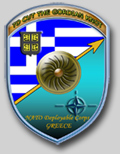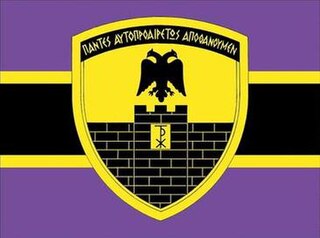
Ioannis Metaxas was a Greek military officer and politician who was Prime Minister of Greece from 1936 until his death in 1941. He governed constitutionally for the first four months of his tenure, and thereafter as the strongman leader of the 4th of August Regime following his appointment by King George II.

The III Hellenic Army Corps / NATO Rapid Deployable Corps – Greece, abbreviated NRDC-GR, is an operational headquarters of the Hellenic Army, intended for the direction of international operations undertaken by the European Union and NATO. The HQ was originally going to replace the III Army Corps of the Hellenic Army altogether, taking control of its rapid response units, but this was changed in 2009, so that the two HQs essentially co-exist as a joint formation, each controlling different units of the old Army Corps. The Corps is based in the city of Thessaloniki since 1946.
The I Army Corps was an army corps of the Hellenic Army, founded in December 1913. Originally based in Athens and covering southern Greece, since 1962 it was responsible for covering Greece's northwestern borders. It was disbanded in 2013.

The 12th Mechanized Infantry Division "Evros" is a military formation of the Hellenic Army, based at Alexandroupoli, Thrace.

The 16th Mechanized Infantry Division "Didymoteicho" is a mechanized infantry division of the Hellenic Army.

At the outbreak of World War I in August 1914, the Kingdom of Greece remained neutral. Nonetheless, in October 1914, Greek forces once more occupied Northern Epirus, from where they had retreated after the end of the Balkan Wars. The disagreement between King Constantine, who favoured neutrality, and the pro-Allied Prime Minister Eleftherios Venizelos led to the National Schism, the division of the state between two rival governments. Finally, Greece united and joined the Allies in the summer of 1917.
The 3/40 Evzone Regiment or 40th Evzone Regiment is a historic regiment of Evzones of the Hellenic Army, recruited in Epirus and headquartered in Arta. It was formed in 1913 after the Balkan Wars, and disbanded in the post-World War II period. It exists today as a nominal reserve formation to be mobilized in wartime.
The following is the order of battle of the Hellenic Army during the First Balkan War of 1912–1913.

The 5th Airmobile Brigade "5th Cretan Division", formerly the 5th Infantry Division and commonly referred to simply as the Cretan Division, is an air assault brigade of the Hellenic Army responsible for the defense of the southern Aegean sea.

The 10th Infantry Regiment "(10 ΣΠ)" is a motorized infantry Regiment of the Hellenic Army. Headquartered in Serres and subordinated to the III Army Corps, it was formed from the former 10th Infantry Division on 1 July 2004.
The Smyrna Division was an infantry division of the Hellenic Army, active in 1919–1920 during the Asia Minor Campaign.
The V Army Corps, sometimes found as Army Corps E, was an army corps of the Hellenic Army, active in the struggles in Northern Epirus in 1913–1914 and in the Greco-Italian War.
The Archipelago Division was an infantry division of Greece in World War I and the early stages of the Asia Minor Campaign.

The 6th Infantry Division was an infantry division of the Hellenic Army.

The 11th Infantry Division was an infantry division of the Hellenic Army.

The 13th Special Operations Command "Sacred Band" was an umbrella unit of the Hellenic Army's special operation forces.

The Army of National Defence was the military force of the Provisional Government of National Defence, a pro-Allied government led by Eleftherios Venizelos in Thessaloniki in 1916–17, against the royal government of King Constantine I in Athens, during the so-called National Schism. By the spring of 1917, it comprised three infantry divisions that formed the National Defence Army Corps and fought in the Macedonian front. Following the ousting of King Constantine and the reunification of Greece under the leadership of Venizelos in June 1917, the Corps continued as part of the reconstituted Hellenic Army until 1920, when it became the Army of Thrace.

The National Defence coup d'état was a military uprising in Thessaloniki on 17 August 1916, by Greek Army officers opposed to the neutrality followed by the royal government in Athens during World War I, and sympathetic to former Prime Minister Eleftherios Venizelos and the Entente Powers. With the support of Entente forces present in the area as part of the Salonica front, the coup established control of Thessaloniki and much of the wider region. Soon afterwards, Venizelos and his leading followers arrived in the city to establish a Provisional Government of National Defence, which entered World War I on the side of the Entente. These events marked the culmination and entrenchment of the "National Schism" in Greek politics.

The 13th Infantry Division was an infantry division of the Hellenic Army.
The 14th Infantry Division was an infantry division of the Hellenic Army.













